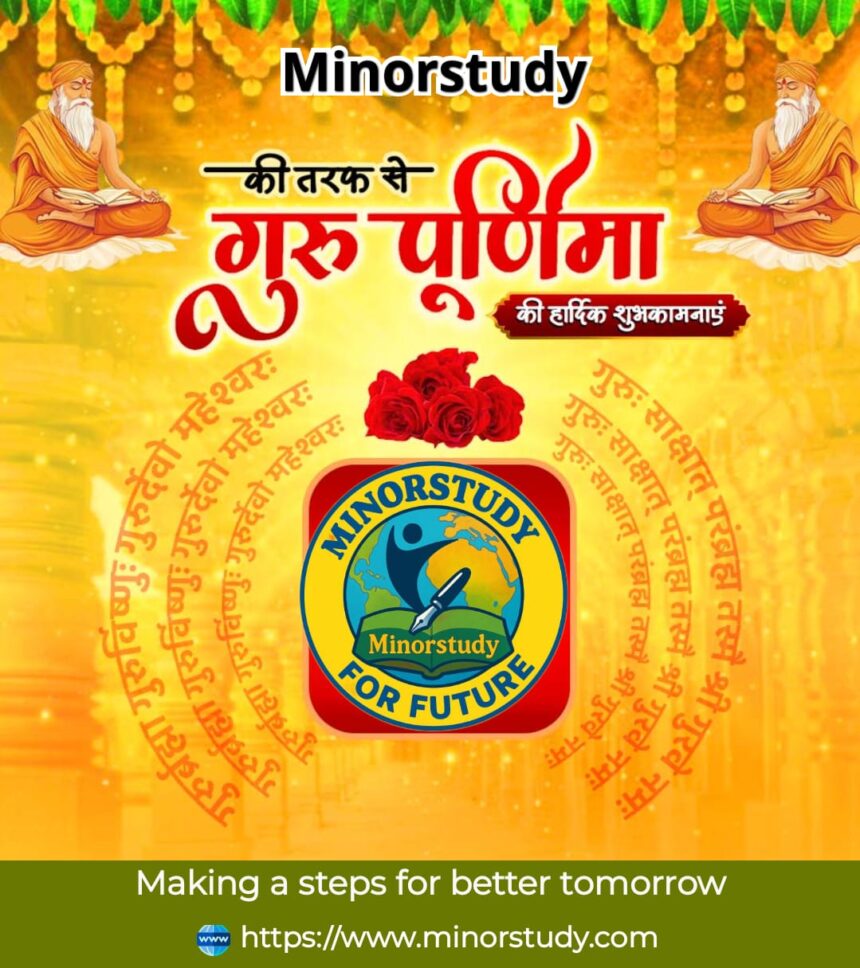🌕 Guru Purnima: A Divine Celebration of Wisdom, Gratitude & Inner Light
“Guru Govind dou khade, kaake laagoon paay; Balihari Guru aapki, Govind diyo batay.”
(“When Guru and Govind stand together, whose feet do I touch first? I bow to the Guru, for he is the one who showed me the path to God.”)
- 📖 History of Guru Purnima: A Legacy Rooted in Light
- 🧭 Timeline of Guru Purnima Celebrations
- 🌟 7 Heartfelt Reasons Why Guru Purnima Is the Most Soulful Day
- 1. A Day of Deep Gratitude
- 2. It Honors Timeless Wisdom
- 3. It Transcends Religions
- 4. A Catalyst for Self-Reflection
- 5. A Teacher’s Real Reward
- 6. Strengthens Cultural Bonds
- 7. A Reminder of Our Higher Self
- 📚 Must-Know Facts About Guru Purnima
- 🌍 Observance & Celebrations Across India
- 💭 Human-Centric Meaning: Why It Matters in Daily Life
- 🙏 Heartfelt Wishes for Guru Purnima
- ❓FAQs – People Also Ask
- 🔑 Important Points Recap
- 🧘 Conclusion: Walking the Path Lit by the Guru
Guru Purnima, one of the most spiritually charged and emotionally resonant festivals, is a tribute to the guiding lights of our life — our Gurus. Celebrated with love and reverence across India, Nepal, and other parts of Asia, this day is not just about religious rituals but a deeply personal observance of wisdom, discipline, and transformation.
Let’s explore the rich history, fascinating facts, significance, timeline, observance, societal importance, and heartfelt wishes around Guru Purnima — in a warm, human-friendly tone and with over 1200 words of depth and devotion.
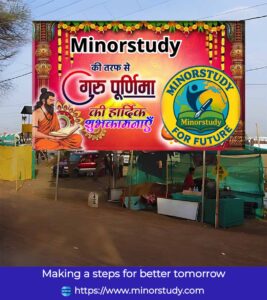
📖 History of Guru Purnima: A Legacy Rooted in Light
The origins of Guru Purnima are ancient and transcend religious boundaries.
The festival traces back to the Vedic age, where the Guru-Shishya (teacher-disciple) tradition was the foundational element of learning.
It is celebrated on the full moon (Purnima) of the Ashadha month (June–July).
The day is dedicated to Maharishi Ved Vyas, the legendary sage who compiled the Vedas, authored the Mahabharata, and structured the Puranas. Thus, it’s also called Vyasa Purnima.
For Buddhists, this is the day when Gautama Buddha gave his first sermon at Sarnath, making it equally sacred.
For Jains, Lord Mahavira made Indrabhuti Gautam his first disciple on this day.
In essence, it is a festival of universal gratitude — a day to honor anyone who has imparted wisdom, spiritual or otherwise.
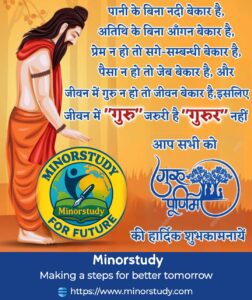
🧭 Timeline of Guru Purnima Celebrations
| Period | Event |
|---|---|
| 5000 BCE | Guru-Shishya tradition flourishes in Gurukuls |
| 3000 BCE | Maharishi Vyas born; considered the Adi Guru |
| 528 BCE | Gautama Buddha gives first sermon on Ashadha Purnima |
| 5th Century CE | Vyas Purnima formally observed in Indian calendar |
| Modern Era | Schools, ashrams, and communities celebrate Guru Purnima with events, prayers, and dedications |
🌟 7 Heartfelt Reasons Why Guru Purnima Is the Most Soulful Day
1. A Day of Deep Gratitude
Guru Purnima reminds us to pause and express thanks to those who’ve shaped our minds, morals, and missions in life — be it a schoolteacher, a spiritual master, a parent, or a mentor.
2. It Honors Timeless Wisdom
This day commemorates Maharishi Ved Vyas, the torchbearer of knowledge and compiler of sacred texts. His legacy still forms the backbone of Indian education, ethics, and spirituality.
3. It Transcends Religions
From Hinduism to Buddhism to Jainism, Guru Purnima is inclusive — celebrating wisdom over dogma, teacher over tradition.
4. A Catalyst for Self-Reflection
Many spiritual seekers observe silence, fasts, and introspection on this day. It becomes a day to look within, assess one’s spiritual progress, and reconnect with one’s inner voice.
5. A Teacher’s Real Reward
For gurus and teachers, seeing their students evolve and express heartfelt respect is a reward beyond material gifts. It rekindles the purpose behind their noble work.
6. Strengthens Cultural Bonds
In schools, ashrams, and families, Guru Purnima brings people together in a spirit of unity, devotion, and learning, reaffirming India’s cultural fabric.
7. A Reminder of Our Higher Self
The word “Guru” means “one who dispels darkness.” Guru Purnima invites us to seek that light — whether from a master or from within — and strive to live with greater awareness.
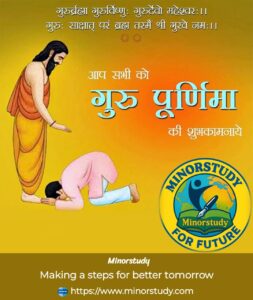
📚 Must-Know Facts About Guru Purnima
Guru = Gu (darkness) + Ru (remover) — the one who removes ignorance.
Celebrated on Ashadha Purnima, typically in June or July.
Also known as Vyasa Purnima.
Observed in Hindu, Buddhist, and Jain traditions.
Gautama Buddha gave his first sermon on this day in Sarnath.
Spiritual seekers begin their new sadhana (practice) or vow of discipline on this day.
Modern Indian saints like Swami Vivekananda, Ramana Maharshi, and Sai Baba emphasized its importance.
🌍 Observance & Celebrations Across India
In Schools and Colleges:
Students honor teachers with flowers, poems, and cards.
Cultural programs and ‘Guru Vandana’ events are organized.
In Ashrams and Spiritual Centres:
Disciples offer pujas, chant mantras, perform paduka pooja (worship of Guru’s feet).
Satsangs, bhajans, and community meals are arranged.
At Home:
People take time to remember and honor parents, elders, mentors, and even life experiences that taught valuable lessons.
Many also use this day to donate to educational causes or help underprivileged students.
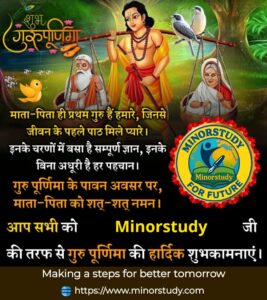
💭 Human-Centric Meaning: Why It Matters in Daily Life
In a fast-paced world where material success is glorified over inner peace, Guru Purnima brings our focus back to values, character, and purpose.
It teaches us:
To respect learning and those who impart it.
To stay humble and grateful.
To reflect, reset, and redirect our lives towards the light of truth and wisdom.
🙏 Heartfelt Wishes for Guru Purnima
💫 “To the one who showed me the path when I was lost, thank you. Happy Guru Purnima!”
💫 “May your Guru’s light always guide you through darkness. Happy Guru Purnima!”
💫 “A teacher is a candle that lights countless lamps. Today we bow in gratitude.”
💫 “Blessed are we who have found our Guru. May the light of wisdom never fade.”
🪔 Minorstudy salutes all Gurus — spiritual, academic, familial, or universal.
❓FAQs – People Also Ask
Q1. Who is the original Guru?
Maharishi Ved Vyas is considered the Adi Guru for compiling sacred knowledge. Spiritually, for many, Guru is the divine itself in human form.
Q2. Is Guru Purnima only for spiritual teachers?
No. It’s for anyone who has guided you — school teachers, life mentors, parents, coaches, etc.
Q3. Why is the Guru called greater than God?
Because the Guru leads you to God, helping you overcome ignorance. The Guru is the bridge to the divine.
Q4. What can I gift to my Guru on this day?
Offer respect, discipline, a promise to live by their teachings, or even a handwritten note of gratitude.
Q5. How can children celebrate Guru Purnima?
By thanking their teachers, helping parents, making appreciation cards, and learning about their spiritual heritage.
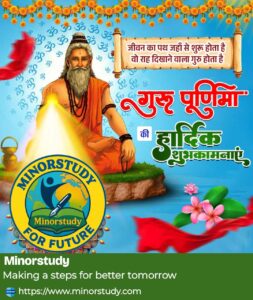
🔑 Important Points Recap
Guru Purnima is celebrated on Ashadha Purnima (June–July).
Honors Maharishi Vyas, Gautama Buddha, and all Gurus.
A day for gratitude, learning, and self-improvement.
Observed through pujas, silence, satsang, and acts of reverence.
Involves everyone from saints to schoolteachers.
Relevant across Hindu, Buddhist, Jain and secular traditions.
🧘 Conclusion: Walking the Path Lit by the Guru
Guru Purnima is more than a festival — it’s a feeling, a philosophy, and a promise.
In a world brimming with information, the Guru gives wisdom.
Amidst noise, the Guru brings clarity.
And through life’s chaos, the Guru shows the way back to peace.
Let us not only remember our Gurus on this day but strive to become better students of life, spreading the light we’ve received.
💙 To every teacher, every mentor, and every spiritual guide — our heartfelt pranam.

